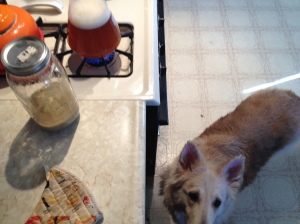Category Archives: elements
Tibetan origins of lager yeast?
Vectored from Current Biology via Ed’s Beer Site:
It has been clear that the lager yeast is a hybrid with one portion of its genome having originated from S. cerevisiae ale yeast [2] . However, the source of the non-ale subgenome, which endows lager yeast with cold tolerance, had been a matter of debate [3] . Recently, a Patagonian origin hypothesis of lager yeast has been proposed based on the discovery of a new cryotolerant Saccharomyces species from Patagonian native forests of Argentina [4] . This yeast, named S. eubayanus, exhibited the closest known match (99.56%) to the non-ale portion of lager yeast and, thus, was believed to be its progenitor. However, we now show that this yeast species is likely native to the Tibetan Plateau. One of the Tibetan populations of the species exhibits closer affinity with lager yeast than the Patagonian population as inferred from population genetics and genome sequence analyses. We thus provide strong evidence for a Far East Asian origin hypothesis of lager yeast, which apparently corresponds better with geography and world trade history.
Pretty cool – and much more intuitive than a Patagonian origin, what with the aforementioned geography and history (maybe it traveled via a horsehide bagful of kumis strapped to some Mongolian saddle?), and also what with China as a possible origination point for the Saccharomyces species.
Hardly scientific, but Tibetan monks and bock-brewing Franciscans in the Alps make a pleasing kind of cultural symmetry. Plus: yetis.
tasting notes: SMASH MILD
reader question: British ale fermentation techniques
Reader and Berliner Weisse brewer Scott hit me with this recently, and it was too chewy to not repost here:
So I recently came across this thread on Homebrew Talk ( http://www.homebrewtalk.com/f163/british-yeasts-fermentation-temps-profiles-cybi-other-thoughts-221817/).
Anyway, my initial question has less to do with the subject of the thread (ferm temps) but more to do with something one of the responders noted. His premise was that for lack of a better term “head pressure” during fermentation didn’t allow full expression by some of these British yeasts. He advocated an “open” or “semi-open” fermentation. I was wondering what your thoughts on this subject matter? Would a closed environment have an off affect than an open free release of gases environment?
steel cage floor-malted death match brew day: SMASH MILD
Such a melodramatic title with so many adjectives for a post about a 3% abv beer! Let’s start over:
this just in: yeast makes beer
A little factoid [edited for accuracy – thanks, citizens!] item of information for a Wednesday:
59% of aroma descriptions and 79% of flavor descriptions on the ASBC Flavor Wheel are created or modified by yeast.
playlist for a yeast propagation
Building up the anointed Czech strain from the Library of Ancient Yeast. The Old One demands some jams to accompany its emergence from dormancy. Continue reading
ptyalin
“Thus, it is known that the preparation of some native beers that used cereals as a source of extract involved a step where the grains were masticated by the brewer. In so doing, the addition of saliva, which contains the amylase, ptyalin, would partially degrade the starch content of the grain and thereby increase the fermentability of the wort. It is interesting to conjecture as to the train of empiricism that culminated in this process!”
Boulton & Quain, Brewing Yeast and Fermentation
It’s absolutely true, but you know, I never thought about all the misfires and shuffling steps (spits?) that had to’ve led to that discovery.
I’m drinking hydrometer samples
I’m just about to sod off to the GABF for the rest of the week (times change, citizens) but before I go, a quick update on the last batch: Continue reading
reader question: desert island yeast strain
Sorry to do this two posts in a row, citizens, but this one is a stumper (and worthy of debate). Andrew writes:
I have recently moved to China. I will be in the US to see some friends in a couple of weeks and intend to bring a supply of hops and yeast back to China.
My question is, “what yeast would you take to China for a years worth of brewing?” Is there a strain that you absolutely couldn’t live without?
First off – unfair question!
I’ll do what I always do when I inevitably get asked what my favorite beer is, and give multiple answers. So secondly, yes – several strains.
Here’s my highly subjective and somewhat evasive, possibly unhelpful in narrowing it down, desert island list for broad categories I brew within at least a couple times a year:
- for American-style ales: 1056 ‘merican
- for Weizens: 3068 Weihenstephan
- for Belgian-style ales: 3787 Trappist … or maybe 3522 Ardennes
- for Bavarian lagers: 2487 Hella Bock
- for Czech lagers: 2782 Staro Prague
- for British ales: 1275 Thames Valley … or maybe 1469 West Yorkshire
And yours?




